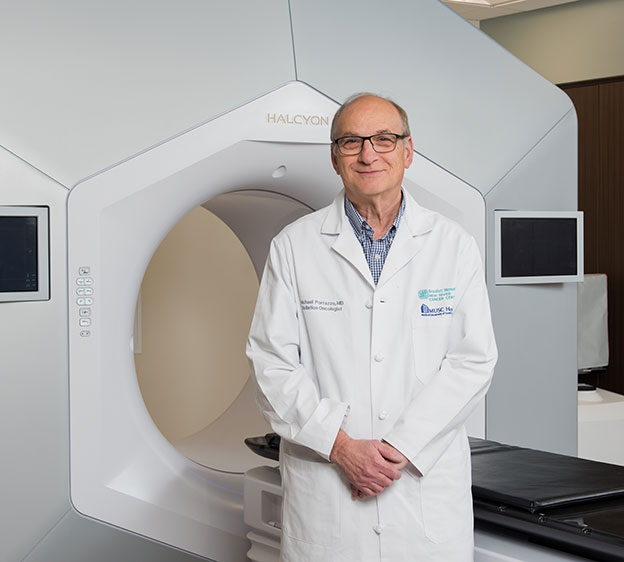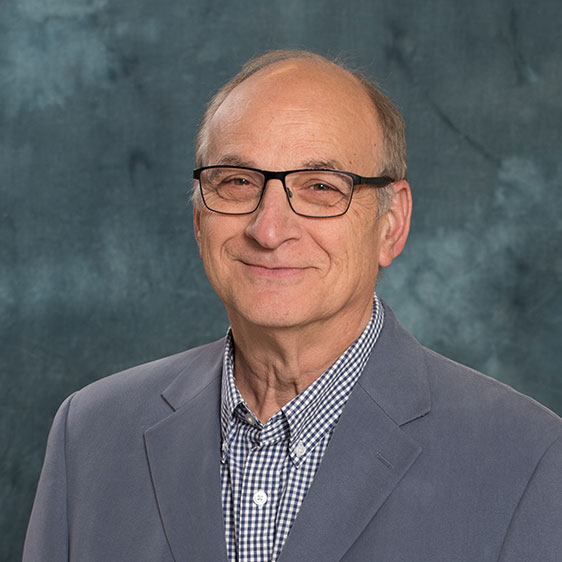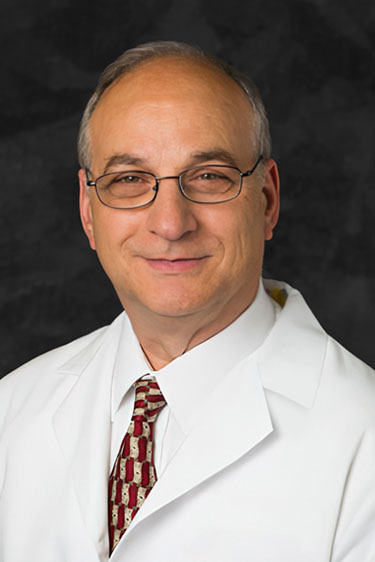Dr. Michael Porrazzo: Linear Accelerators, Wonky Cars and Gluten-Free Stuffing
July 25, 2024Categories: Cancer Care

Dr. Michael Porrazzo says he was on his way to an attractive position running a radiation center in Key West, Florida, when he was convinced to stop by Beaufort Memorial to entertain what he considered a secondary job opportunity in a place he didn’t know.
He never made it to Key West.
The new Okatie Medical Pavilion had recently been completed, and the New River Cancer Center, which is housed in the pavilion, was building out an advanced oncology practice. Along with the new facilities, Beaufort Memorial purchased the Varian Halcyon™ Linear Accelerator radiotherapy system — a state-of-the-art, image-guided radiation therapy platform.
“I walked in and saw the facilities and this incredible machine and just said, ‘Well, this is it,’” Dr. Porrazzo says. “Some people could say, ‘you’re overstating it,’ but it really is a very beautiful piece of machinery.”
Indeed, for Dr. Porrazzo, being at the forefront of radiation technology has, second only to his children, defined his adult life.
“Whenever I see a new patient and they’re considering treatment, I take them for a tour of the Halcyon and let them see the equipment because it sort of takes, I think, a bit of the fear out of going through cancer treatment to see this very modern technology.”
Read More: Radiation 101: What to Expect During Radiation Treatment for Cancer
Three Phases of Trendsetting Treatment
Dr. Porrazzo breaks his experience prior to coming to Beaufort Memorial into three phases of technology-based adventures. In the early 90s, he joined Washington Hospital Center in Washington, D.C. There, he worked with a urologist to start a radiation seed implantation program for prostate cancer patients.
“The treatment had just been popularized in New York, where I’m from,” he says. “But when I came to Washington, nobody was doing that process. It was a very exciting time.”
The technology is now an established treatment and is employed by Dr. Louis Remynse., a board-certified urologist at Beaufort Memorial Urology Specialists.
But the excitement didn’t stop there. A few years later, the hospital was working on a groundbreaking approach for patients undergoing angioplasty procedures to widen arteries or veins. There was a high risk of repeated blockage of the heart vessels and radiation was found to reduce this risk.
“Again, it was wonderful to be a contributor to this very exciting technology,” Dr. Porrazzo says. "We got to travel throughout the world to discuss it.”
The third phase involved a novel device called a gamma knife, which is a form of stereotactic radiation treatment used to treat very small lesions in the brain.
“The way I used to describe the procedure to patients was that, when I was a child, everybody’s mom would go to the hairdresser on Saturday and they’d sit under this bonnet dryer for hours,” he explains. “The gamma knife device looked a lot like that. It had all these holes in it and, rather than hot air coming out, each of those holes let out a small beam of radiation and they intersected at one spot. The goal was to make sure this ‘spot’ lined up with the treatment site.”
“Why do I say all of this?” Dr. Porrazzo hypothetically asks. “Because I feel that I’ve been very fortunate again to come here and to be part of this cutting-edge known as the Varian Halcyon.”
Read More: Debunking Common Myths About Radiation Treatment
New York Sports and a “Wonky” Car Collection

While Dr. Porrazzo is undeniably passionate about radiation therapy technology, at home you’ll likely find him watching a Knicks, Jets or Yankees game while working on his diecast model car collection.
He grew up in The Bronx, New York, in the 1960s. Consequently, he came of age during one of New York City’s greatest sporting eras.
“We had the Knicks, the Mets and the Jets win championships one after the other,” Dr. Porrazzo recalls. “And Joe Namath was just a once-in-a-lifetime individual. Then, in the 80s, George Steinbrenner made the Yankees a very exciting team.”
Regarding his car collection cars, he says it’s a bit like re-living my youth.
“Back in the 60s, there were these diecast cars called Corgi cars,” Dr. Porrazzo says. “They were metal with real rubber tires, and every few months they’d outdo themselves with a new version,” that he and his childhood friend, Nicky (a nickname for Yoshihiro Naka), used to both collect. Dr. Porrazzo says much of his childhood collection was lost over time, but he has since remade it.
“Part of my collection is what I call ‘taxis of the world,’” he says. “I’ve got an Ethiopian taxi, an Italian taxi; I’ve got them from all different countries.”
A Celiac Family Dinner
Another recent event, of sorts, in Dr. Porrazzo’s life journey has been receiving a diagnosis of celiac disease.
“And I’m an Italian!” he exclaims. “What does an Italian eat? Bread and pasta, right? So, now I’ve been searching for ways to find foods that make you feel like you’re still alive and enjoying eating.”
He says he’s been using some of his mother’s old recipes and reworking them to be gluten-free.
“Believe it or not, I’ve found a way to make gluten-free stuffing,” Dr. Porrazzo says.
Being Italian, large family meals are also an essential aspect of his life.
‘I’m a single father,” Dr. Porazzo says. “It’s been challenging to be a full-time doctor and a single dad. But you have to do your best to make something good out of it. So, home life has been a big focus.”
And the key to that was always family dinners, especially events like Thanksgiving.
“I love it when my kids come here,” he says. “We eat together and have a great time.”
Have questions about available cancer treatments? Speak with one of our Cancer Care Navigators.

